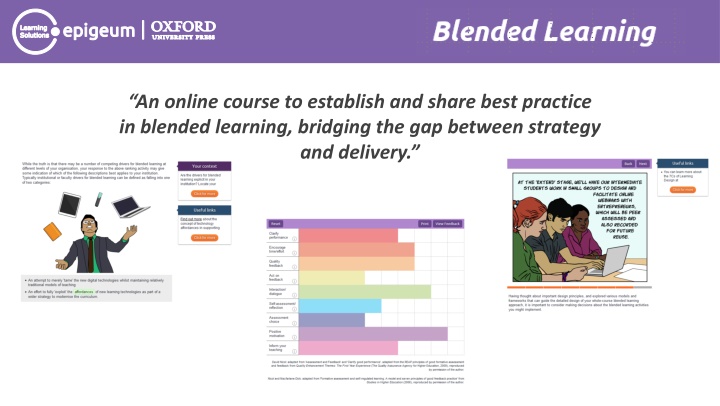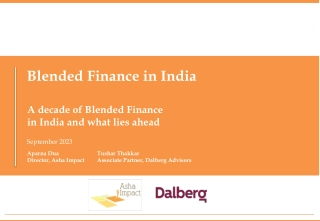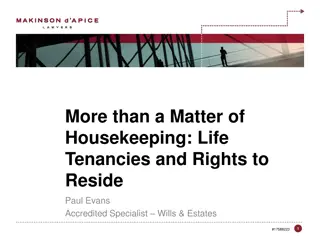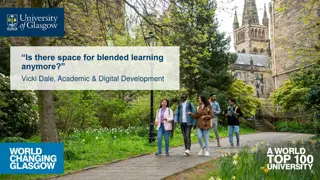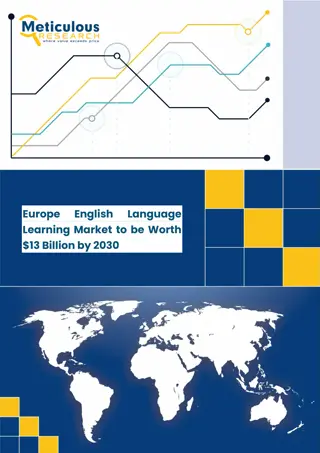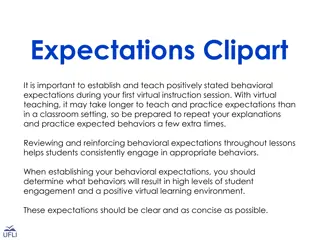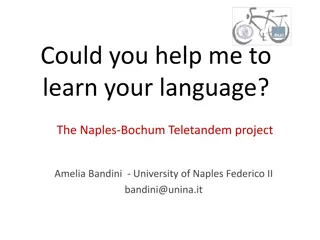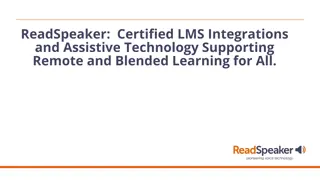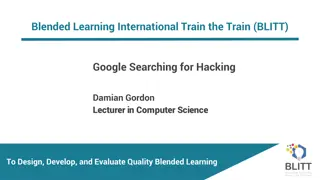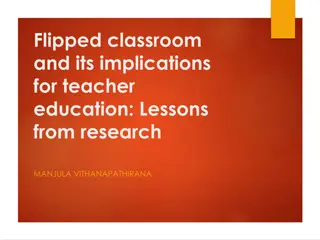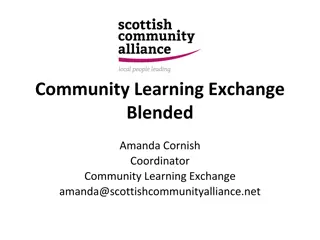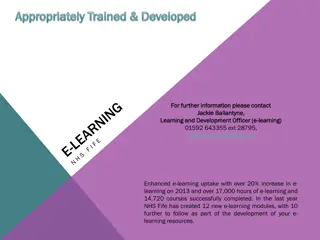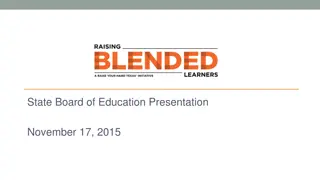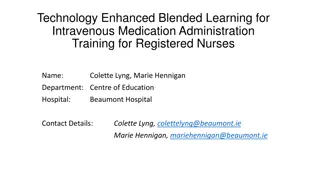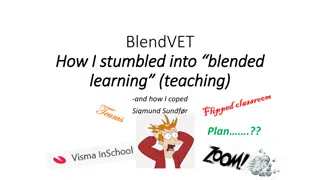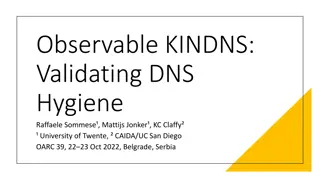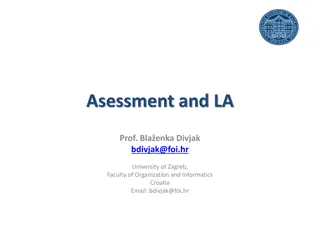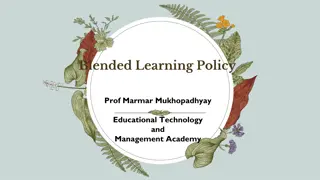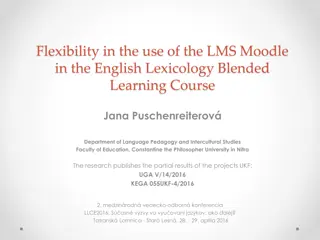Establishing Best Practices in Blended Learning
Blended Learning online course designed by leading experts and universities to bridge gap between theory and practice. Empower lecturers to enhance teaching and learning, improving student performance and engagement. Collaborated with top institutions worldwide
Download Presentation

Please find below an Image/Link to download the presentation.
The content on the website is provided AS IS for your information and personal use only. It may not be sold, licensed, or shared on other websites without obtaining consent from the author.If you encounter any issues during the download, it is possible that the publisher has removed the file from their server.
You are allowed to download the files provided on this website for personal or commercial use, subject to the condition that they are used lawfully. All files are the property of their respective owners.
The content on the website is provided AS IS for your information and personal use only. It may not be sold, licensed, or shared on other websites without obtaining consent from the author.
E N D
Presentation Transcript
Blended Learning An online course to establish and share best practice in blended learning, bridging the gap between strategy and delivery.
Blended Learning Introduction Comprised of seven online courses, Blended Learning brings together a group of leading experts and universities to establish and share best practice in blended learning, positioned at the cutting edge of technology-enhanced learning. The programme aims to bridge the gap between strategy and delivery by empowering lecturers to translate principles and aims into effective teaching and learning practice. This will in turn lead to corresponding improvements in student performance, engagement, satisfaction and retention. Developed in collaboration with: Lead Advisor Bournemouth University, UK Mary Immaculate College, Republic of Ireland Oslo and Akershus University College of Applied Sciences, Norway Professor Mark Brown, Director of the National Institute for Digital Learning at Dublin City University Federation University, Australia Frankfurt University of Applied Sciences, Germany University of Canberra, Australia University of Limerick, Republic of Ireland Gulf University for Science and Technology, Kuwait University of Newcastle, Australia University of Ottawa, Canada Institute of Technology Sligo, Republic of Ireland Limerick Institute of Technology, Republic of Ireland
Blended Learning What is the Blended Learning programme? Leading experts share best practice in blended learning with techniques at the cutting edge of technology-enhanced learning. Bridges the gap between theory and practice allowing your lecturers to deliver effective teaching and learning. Focuses not only on teaching and learning participants can also find information on approaches to student assessment and to evaluation of blended courses. With a variety of courses, 7 altogether, to choose from the programme contains material for lecturers at the start of their careers, to those who are already experienced in delivering blended learning. Video screenshot from course Approaches to Blended Learning : Implementing a blended delivery (module)
Blended Learning Contributors Authors: Professor Mark Brown - Director of the National Institute for Digital Learning at Dublin City University Leah Holroyd - Educational Designer at the University of Canberra Matthew Newcombe - Head of e-Learning at the University of Exeter Professor Keith Smyth - Professor of Pedagogy at the University of the Highlands and Islands Dr Ang lica R squez - Educational Developer at the Centre for Teaching and Learning at the University of Limerick Bryan Fletcher - Director for Publishing (E-learning), Implementation and Impact at Epigeum Reviewers: Neil Currant - Principal Lecturer in Educational Development at the Oxford Centre of Staff and Learning Development Dr Amanda Jefferies - Professor in Technology Enhanced Learning at the University of Hertfordshire Professor Barney Dalgarno - Professor and Director of uImagine, Charles Sturt University's Digital Learning Innovation Laboratory Professor Rhona Sharpe - Head of the Oxford Centre of Staff and Learning Development at Oxford Brookes University
Blended Learning About the course Who is it for? Lecturers and faculty already or about to use a Structure: 12 hours, 30 minute online programme blended learning approach in their teaching, Comprised of seven courses: 1. Why blend? 2. Approaches to blended learning 3. Innovating with blended learning: First steps 4. Developing and implementing a whole-course approach to blended learning 5. Redesigning assessment for blended learning 6. Evaluating and refining your blended course 7. Building a sustainable blended learning culture and looking to improve their skills and understanding of combining face-to-face with online teaching and assessment. Published: June 2016 26 hours, 45 minutes of supplementary materials
Blended Learning Overview and content Syllabus Syllabus Course and Times Course and Times Authors/Reviewers Authors/Reviewers Understand the broader context and benefits of the move towards technology enhanced and online learning on-campus (including an overview of the research evidence) Define blended learning in the context of their university, department and course Identify some common benefits and opportunities provided by blended learning approaches Identify some common problems and challenges with blended learning (e.g.: unfocused combination of online and face-to-face teaching methods; choosing the most appropriate blended approach) Reflect on their own experience of online and blended teaching to date and use this information to create a plan for getting the most out of the remaining courses in the programme Author: Professor Mark Brown, Director of the National Institute for Digital Learning at Dublin City University Why blend? Core: 1 hour, 35 minutes Additional: 3 hours, 35 minutes Explain the principles of a range of blended learning models and approaches (e.g.: flipped classroom, student choice in the classroom, discussion forums) Use case studies from others teaching to illustrate how these approaches work in practice, and the opportunities and challenges associated with each Evaluate each approach in relation to their own particular teaching context, in order to identify those that are likely to be most suitable for their needs This course will be informed throughout by case studies by practitioners of blended learning Author: Leah Holroyd, University of Canberra Approaches to blended learning Core: 2 hours Additional: 3 hours Reviewer: Neil Currant, Oxford Brookes University
Blended Learning Course and Times Course and Times Innovating with blended learning: first steps Syllabus Syllabus Authors/Reviewers Authors/Reviewers Overview and content Identify potential changes and how to implement them Identify different tools, technologies and resources to support blended approaches/course design Understand the benefits of the university s Virtual Learning Environment (VLE)/ Learning Management System (LMS) Understand how video can be used effectively, and create short videos to explain and introduce concepts Author: Matthew Newcombe, University of Exeter Core: 2 hours Additional: 4 hours, 20 minutes Reviewer: Dr Amanda Jefferies, University of Hertfordshire Developing and implementing a whole-course approach to blended learning Understand the importance of creating a learning-centred environment for students and teachers Explain how their role and experience as a teacher will change in the blended environment Identify frameworks and design tools for use in a blended approach (including online spaces, 3E Framework, online resources) Prepare students to succeed in this new environment by providing guidance and orientation Understand the stages involved in a technical and reality check prior to going live with the full blended course or programme Monitor and review the course or programme Author: Professor Keith Smyth, University of the Highlands and Islands Reviewer: Professor Barney Dalgarno, Charles Sturt University Core: 1 hour, 50 minutes Additional: 3 hours, 40 minutes Redesigning assessment for blended learning Outline the range of online assessment methods available to them including: 1. Formative assessment models giving immediate feedback to students 2. Summative assessment models giving feedback at the end of a learning cycle 3. Assessment of graduate attributes Understand the range of technologies that can be used in assessment Understand the implications of student assessment workload Evaluate these online assessments in relation to their own plans and needs Author: Dr Ang lica R squez, University of Limerick Core: 1 hour, 40 minutes Additional: 4 hours, 45 minutes Reviewer: Neil Currant, Oxford Brookes University
Blended Learning Overview and content Syllabus Syllabus Course and Times Course and Times Authors/Reviewers Authors/Reviewers Outline the sources of data (both online and offline) that they can use to gather feedback in order to increase their understanding of class processes and evaluate the effectiveness of their blended approach Use this data to make further modifications and improvements with the aim of supporting student success and improving retention Understand the use of tools to create evaluation methods Apply analytics to improve the success of the blended approach and to understand issues of data protection Author: Bryan Fletcher, Director of Publishing, Epigeum Evaluating and refining your blended course Reviewer: Dr Amanda Jefferies, University of Hertfordshire Core: 2 hours Additional: 3 hours, 35 minutes Gather evidence to evaluate the institution s current blended learning practice and culture, and assess this in relation to the overall blended learning strategy Use the above information to identify priorities and action plans Identify some of the challenges inherent in seeking to change embedded practices/cultures and employ a range of change management strategies to mitigate these including: 1. Using different types of influence 2. Identifying and working with change leaders in each department and creating communities of practice 3. Using this programme to expand the skills sets of teaching faculty Develop a network of experts in each department to lead/inspire colleagues and to quickly deal with issues and identify risks Identify and understand the resources required to implement a sustained blended approach and possible frameworks to aid implementation Author: Matthew Newcombe, University of Exeter Building a sustainable blended learning culture Reviewer: Professor Rhona Sharpe, Oxford Brookes University Core: 1 hour, 30 minutes Additional: 3 hours, 50 minutes
Blended Learning Course features Interactive activities and scenarios. Lots of opportunities for active engagement, including portfolio activities, cloze activities, ranking activities and comic strips. Video interviews with academics and Teaching and Learning co- ordinators. You will also hear from students and teaching assistants. Presentational activities to communicate important information as clearly as possible; for instance, labelled graphics, flashcards, ladder steps All 7 courses have a practice scenario, where users can undertake activities that take key learning points from the course and develop them Course summary screens tie together the main points, and there is a course quiz for participants Example from Evaluating and refining your blended course Tools for evaluation (module)
Blended Learning What does it look like? Video interviews Interactive activities
Blended Learning What does it look like?
Blended Learning Support materials for Blended Learning available from: https://www.epigeum.com/customer- support/implementation-toolkit/course- tools/blended-learning/
